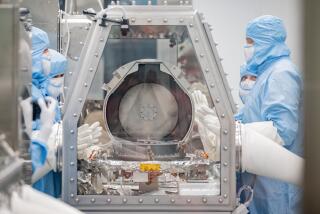Mars rock ‘Jake Matijevic’ proves a surprise, even to NASA
The more Curiosity gets to know Mars, the more it seems like a big red Earth. Curiosity recently examined what appeared to be an ancient riverbed and conglomerate rocks similar to those at home. Now comes “Jake Matijevic” -- a pyramid-shaped chunk of rock that’s proved to be a surprise, even to NASA.
The space agency says that Jake, named for a legendary NASA engineer, is unique -- unlike any rocks examined before on Mars. And that’s saying something. Previous rovers have examined hundreds of Martian rocks.
When Curiosity team members picked Jake, they were just hoping for a “simple and uniform” rock that would help them compare results from two chemistry instruments.
Jake was the first rock analyzed by the rover’s arm-mounted Alpha Particle X-Ray Spectrometer; it was about the 30th on this mission examined by the Chemistry and Camera (ChemCam) instrument.
“It’s a strength of Curiosity to have instruments that use different techniques to get at the same answers,” Ashwin Vasavada, Curiosity deputy project scientist, told the Los Angeles Times on Friday morning. “But it’s also a challenge for the science team, like trying to understand the plot of a story when one person saw the movie and another read the book. We were hoping that Jake M. had a simple plot.”
But NASA got more than it expected. The rock was diverse, surprisingly so.
“Our laser instrument saw a slightly different composition at every point it analyzed,” Vasavada said. Although there was “broad agreement between it and another spectrometer that the robotic arm held against the rock, there also are some discrepancies yet to be understood. The differences between the two instruments are telling us that the rock contains a diversity of minerals down to the finest scales.”
The results so far reveal a good match, Vasavada said, for a type of Earth rock.
“We see a composition that is a good match to a rare but widespread rock type on Earth, one that forms deep inside the Earth as magma moves around and partially crystallizes, leaving basalts that are rich in alkali elements like potassium.”
He stressed that scientists can’t be certain Jake formed in the same way as rocks on Earth.
“Like many aspects of planetary exploration,” the scientist noted, “we use the long history of Earth studies to form our best ideas to explain Mars.”
Curiosity is spending about three weeks at Rocknest, the patch of dirt where it recently made its first scoop. After that, the rover team will direct Curiosity 100 yards to the east to do some rock drilling as the pursuit of information on possible previous microbial life on Mars continues.
ALSO:
Baby panda autopsy finds liver, lung damage
Kids need more calories in school lunches, lawmakers say
Kennewick Man: Scientists unravel 9,300-year-old skeleton’s past
Join Amy on Google+. Email: [email protected]
More to Read
Sign up for Essential California
The most important California stories and recommendations in your inbox every morning.
You may occasionally receive promotional content from the Los Angeles Times.










